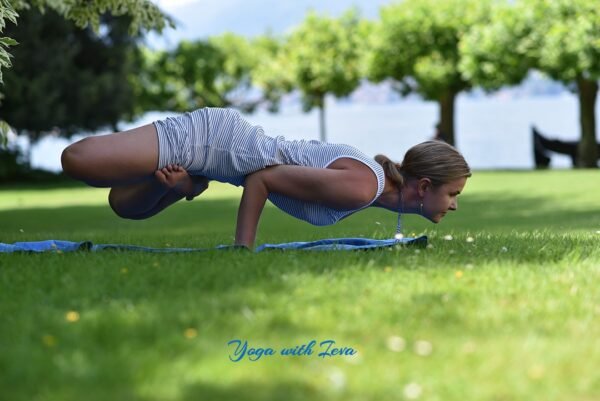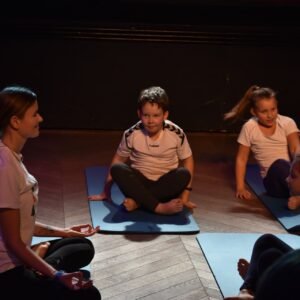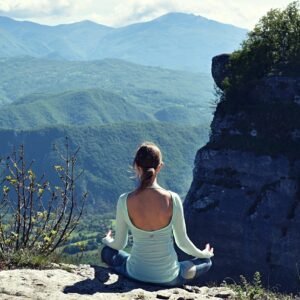Description
Ashtanga yoga is the strongest physically yoga style.
Introduction to the class
Ashtanga vinyasa yoga is one of these systems of Hatha yoga that synchronises breath and movement in a flowing sequence of asanas (postures). Each asana has a unique choreographed number of movements into and out of it. When practised regularly, it can help to develop strength, flexibility, stamina and help to cultivate an all-round feeling of well being and a still and focussed mind.
Poses (asana) are linked in a sequence with each held for a number of breaths (typically 5) breaths before transitioning through a specific series of movements (Vinyasa) to the next pose.
We repeat a set sequence of postures each time we practice, so that the sequence becomes familiar, and in doing so we develop a self practice. It becomes our own daily personal experience of movement and breath awareness, creating an independence in your practice that is empowering.
Vinyasa – synchronised breath and movement progressing through fixed sequences of postures
According to Jacobsen, “Yoga has five principal meanings:
- Yoga as a disciplined method for attaining a goal;
- Yoga as techniques of controlling the body and the mind;
- Yoga as a name of one of the schools or systems of philosophy (darśana);
- Yoga in connection with other words, such as “hatha-, mantra-, and laya-,” referring to traditions specialising in particular techniques of yoga;
I would like also to add the original Yoga meaning translated from Sanskrit language the word ‘yoga’ itself means ‘uniting’ (uniting diverse aspects of existence, of life).
Ashtanga Yoga means 8 limbs and its first known use is in the Yoga Sutras of Patanjali where it describes an 8-part method of
practice. Many of the ideas and practices outlined in the Yoga Sutras had already been developing in India for thousands of years. What makes the Yoga Sutras stand out is that they compiled variegated strands of yogic theory in a systematic way. However, yoga techniques are used by a variety of different traditions alongside that of the Yoga Sutras, which speaks to their versatility.
Sutras are a type of literature that is written in short aphorisms that are meant to be explained through commentary,
and there is a long and rich commentarial tradition associated with the Yoga Sutras. In Patanjali’s original treatise and early commentaries, we don’t see many of the techniques that we recognize in Ashtanga yoga practice today. It is through
the commentarial tradition, that over time we see the introduction of techniques that have influenced modern yoga practice.
Ashtanga Yoga, as practiced today, has it basis in the teachings of T. Krishnamacharya and his student K. Pattabhi
Jois, who evolved this system of linking of breath and movement in sequences of asanas.
Introduction to Yoga
The origins of Yoga have been speculated to date back to pre-Vedic Indian traditions, but most likely developed around the sixth and fifth centuries BCE, in ancient India’s ascetic circles. The chronology of earliest texts describing yoga-practices is unclear, varyingly credited to Hindu Upanishads and Buddhist Pāli Canon, probably of third century BCE or later and The Yoga Sutra was compiled sometime between 500 BC and AD400 by the sage Patanjali in India who synthesised and organised knowledge about yoga from much older traditions.
The Yoga Sutras contain a set of observances and practices to guide your spiritual journey.
“Yoga anga anushtanat ashuddhi kshaye jnanadi Apthiraviveka khyatehe’’ (II Sutra 28)
yoga = yoga; anga = limbs of; anushtanat = by the practise of; ashuddhi = impurities; kshaye = destroyed; jnana = wisdom; diApthihi= the light of; viveka = discrimination; khyatehe = knowledge.
“By the sustained practice of the eight limbs of yoga, the impurities are destroyed and the light of wisdom, discrimination shines forth.”
According to Patanjali Yoga Sutras there are 8 Limbs of Yoga:
- Yama: Correct behaviour toward others.
- Nonviolence – Ahimsa
- Truth – Staya
- Non stealing – Asteaya
- Not wasting energy/moving in brahman – brahmacharya
- Non-accumulation/abstaining of greed – aparigraha.
- Niyama: The principles by which you should live your own life
- Purity – Saucha
- Contentment – Santosha
- Spiritual observances/Austerity – Tapas
- Self-study – Swadyaya
- Devotion/surrender – Ishwara Pranidhana
- Asana(postures): Easy comfortable positions of the body, connecting the mind and spirit to experience stillness and infinity.
- Pranayama(mindful breathing): Expanding the life force and light within through breathing exercises.
- Pratyahara(turning inward): Turning the senses inward to explore the inner universe.
- Dharana(concentration): Effortless focused attention; training the mind to meditate.
- Dhyana(de-concentration): Dropping all the efforts and letting go.
- Samadhi(pure bliss): Constant complete harmony of the self with universe; unity.The first four yamas prepare the body for the next three, which take you to the doorway of the eighth. Dharana, Dhyana, and Samadhi practiced together is known as Sanyama. Settling the mind, having a subtle intention, and releasing it into the field of Infinite Organising Power gives you knowledge of the laws of nature of an object and Yogic Powers (Siddhis).









Reviews
There are no reviews yet.